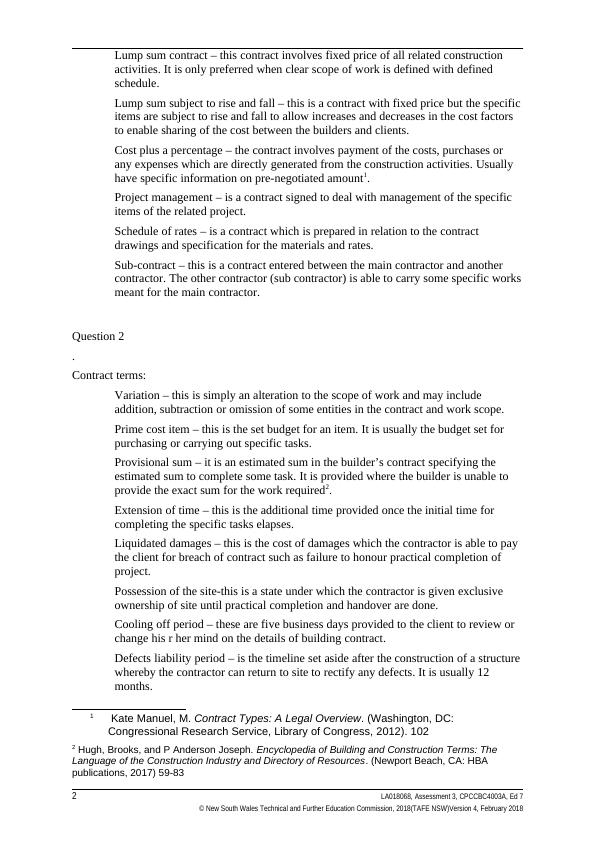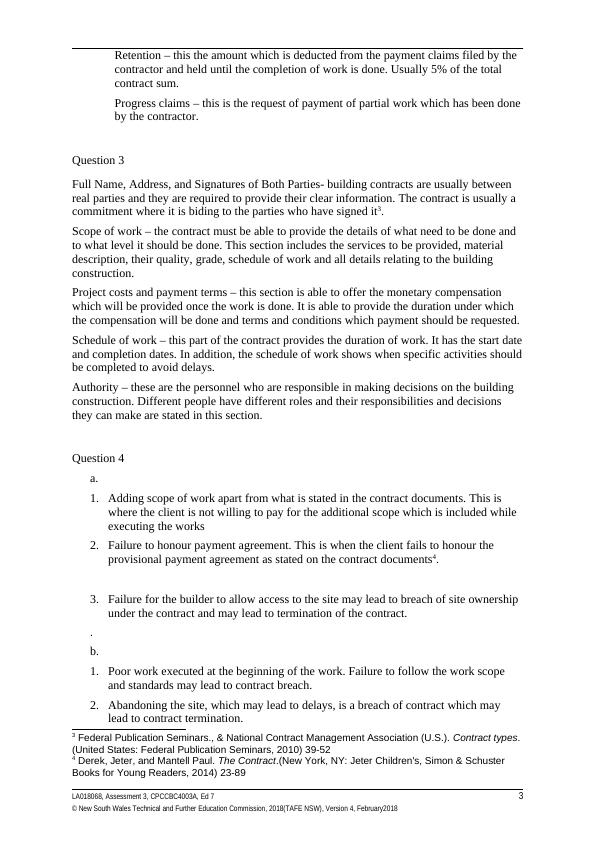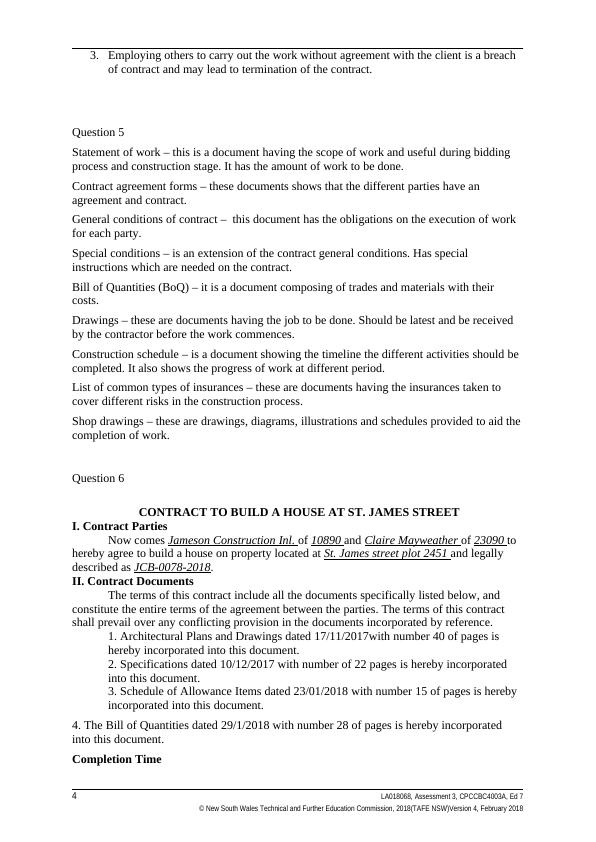(PDF) Fundamentals of Construction Contracts
14 Pages2791 Words78 Views
Added on 2021-04-21
(PDF) Fundamentals of Construction Contracts
Added on 2021-04-21
ShareRelated Documents
Assessment 3Name,Student numberUnit numberAssignment numberQuestion 1Contract types:LA018068, Assessment 3, CPCCBC4003A, Ed 71© New South Wales Technical and Further Education Commission, 2018(TAFE NSW), Version 4, February 2018

Lump sum contract – this contract involves fixed price of all related construction activities. It is only preferred when clear scope of work is defined with defined schedule. Lump sum subject to rise and fall – this is a contract with fixed price but the specificitems are subject to rise and fall to allow increases and decreases in the cost factors to enable sharing of the cost between the builders and clients. Cost plus a percentage – the contract involves payment of the costs, purchases or any expenses which are directly generated from the construction activities. Usually have specific information on pre-negotiated amount1. Project management – is a contract signed to deal with management of the specific items of the related project. Schedule of rates – is a contract which is prepared in relation to the contract drawings and specification for the materials and rates. Sub-contract – this is a contract entered between the main contractor and another contractor. The other contractor (sub contractor) is able to carry some specific worksmeant for the main contractor. Question 2.Contract terms:Variation – this is simply an alteration to the scope of work and may include addition, subtraction or omission of some entities in the contract and work scope. Prime cost item – this is the set budget for an item. It is usually the budget set for purchasing or carrying out specific tasks. Provisional sum – it is an estimated sum in the builder’s contract specifying the estimated sum to complete some task. It is provided where the builder is unable to provide the exact sum for the work required2. Extension of time – this is the additional time provided once the initial time for completing the specific tasks elapses. Liquidated damages – this is the cost of damages which the contractor is able to pay the client for breach of contract such as failure to honour practical completion of project. Possession of the site-this is a state under which the contractor is given exclusive ownership of site until practical completion and handover are done. Cooling off period – these are five business days provided to the client to review or change his r her mind on the details of building contract. Defects liability period – is the timeline set aside after the construction of a structurewhereby the contractor can return to site to rectify any defects. It is usually 12 months. 1 Kate Manuel, M. Contract Types: A Legal Overview. (Washington, DC: Congressional Research Service, Library of Congress, 2012). 1022 Hugh, Brooks, and P Anderson Joseph. Encyclopedia of Building and Construction Terms: The Language of the Construction Industry and Directory of Resources. (Newport Beach, CA: HBA publications, 2017) 59-832LA018068, Assessment 3, CPCCBC4003A, Ed 7© New South Wales Technical and Further Education Commission, 2018(TAFE NSW)Version 4, February 2018

Retention – this the amount which is deducted from the payment claims filed by the contractor and held until the completion of work is done. Usually 5% of the total contract sum. Progress claims – this is the request of payment of partial work which has been doneby the contractor. Question 3Full Name, Address, and Signatures of Both Parties- building contracts are usually between real parties and they are required to provide their clear information. The contract is usually a commitment where it is biding to the parties who have signed it3. Scope of work – the contract must be able to provide the details of what need to be done and to what level it should be done. This section includes the services to be provided, material description, their quality, grade, schedule of work and all details relating to the building construction. Project costs and payment terms – this section is able to offer the monetary compensation which will be provided once the work is done. It is able to provide the duration under which the compensation will be done and terms and conditions which payment should be requested. Schedule of work – this part of the contract provides the duration of work. It has the start dateand completion dates. In addition, the schedule of work shows when specific activities shouldbe completed to avoid delays. Authority – these are the personnel who are responsible in making decisions on the building construction. Different people have different roles and their responsibilities and decisions they can make are stated in this section. Question 4a.1.Adding scope of work apart from what is stated in the contract documents. This is where the client is not willing to pay for the additional scope which is included while executing the works2.Failure to honour payment agreement. This is when the client fails to honour the provisional payment agreement as stated on the contract documents4.3.Failure for the builder to allow access to the site may lead to breach of site ownership under the contract and may lead to termination of the contract. .b.1.Poor work executed at the beginning of the work. Failure to follow the work scope and standards may lead to contract breach.2.Abandoning the site, which may lead to delays, is a breach of contract which may lead to contract termination. 3 Federal Publication Seminars., & National Contract Management Association (U.S.). Contract types. (United States: Federal Publication Seminars, 2010) 39-524 Derek, Jeter, and Mantell Paul. The Contract.(New York, NY: Jeter Children's, Simon & Schuster Books for Young Readers, 2014) 23-89LA018068, Assessment 3, CPCCBC4003A, Ed 73© New South Wales Technical and Further Education Commission, 2018(TAFE NSW), Version 4, February2018

3.Employing others to carry out the work without agreement with the client is a breach of contract and may lead to termination of the contract. Question 5Statement of work – this is a document having the scope of work and useful during bidding process and construction stage. It has the amount of work to be done. Contract agreement forms – these documents shows that the different parties have an agreement and contract. General conditions of contract – this document has the obligations on the execution of work for each party. Special conditions – is an extension of the contract general conditions. Has special instructions which are needed on the contract. Bill of Quantities (BoQ) – it is a document composing of trades and materials with their costs. Drawings – these are documents having the job to be done. Should be latest and be received by the contractor before the work commences. Construction schedule – is a document showing the timeline the different activities should be completed. It also shows the progress of work at different period. List of common types of insurances – these are documents having the insurances taken to cover different risks in the construction process. Shop drawings – these are drawings, diagrams, illustrations and schedules provided to aid thecompletion of work. Question 6CONTRACT TO BUILD A HOUSE AT ST. JAMES STREETI. Contract Parties Now comes Jameson Construction Inl. of 10890 and Claire Mayweather of 23090 to hereby agree to build a house on property located at St. James street plot 2451 and legally described as JCB-0078-2018. II. Contract Documents The terms of this contract include all the documents specifically listed below, and constitute the entire terms of the agreement between the parties. The terms of this contract shall prevail over any conflicting provision in the documents incorporated by reference. 1. Architectural Plans and Drawings dated 17/11/2017with number 40 of pages is hereby incorporated into this document. 2. Specifications dated 10/12/2017 with number of 22 pages is hereby incorporated into this document. 3. Schedule of Allowance Items dated 23/01/2018 with number 15 of pages is hereby incorporated into this document. 4. The Bill of Quantities dated 29/1/2018 with number 28 of pages is hereby incorporated into this document.Completion Time 4LA018068, Assessment 3, CPCCBC4003A, Ed 7© New South Wales Technical and Further Education Commission, 2018(TAFE NSW)Version 4, February 2018

End of preview
Want to access all the pages? Upload your documents or become a member.
Related Documents
Types of Contracts in Construction: Lump Sum, Cost Plus, Time and Material, Unit Pricinglg...
|2
|598
|71
Types of Contracts in Constructionlg...
|27
|5563
|436
Supervising On-Site Medium Rise Building Constructionlg...
|13
|2480
|358
Types of Construction Contracts and the Contracting Process in Project Managementlg...
|10
|1232
|159
Contractual arrangements for a 30-storey tower on a 5-storey podiumlg...
|12
|4171
|136
Contract and Procurement Managementlg...
|16
|621
|338
